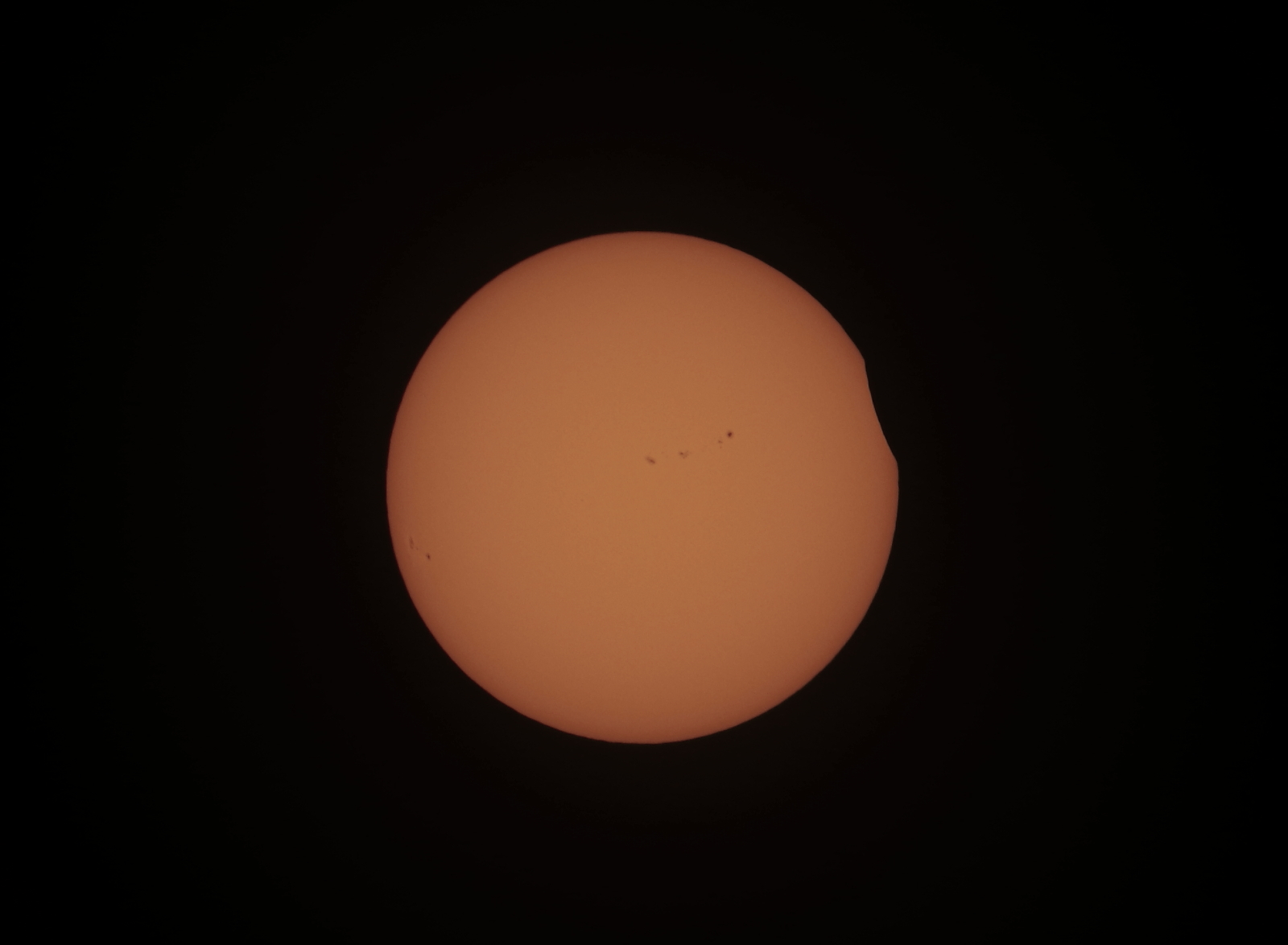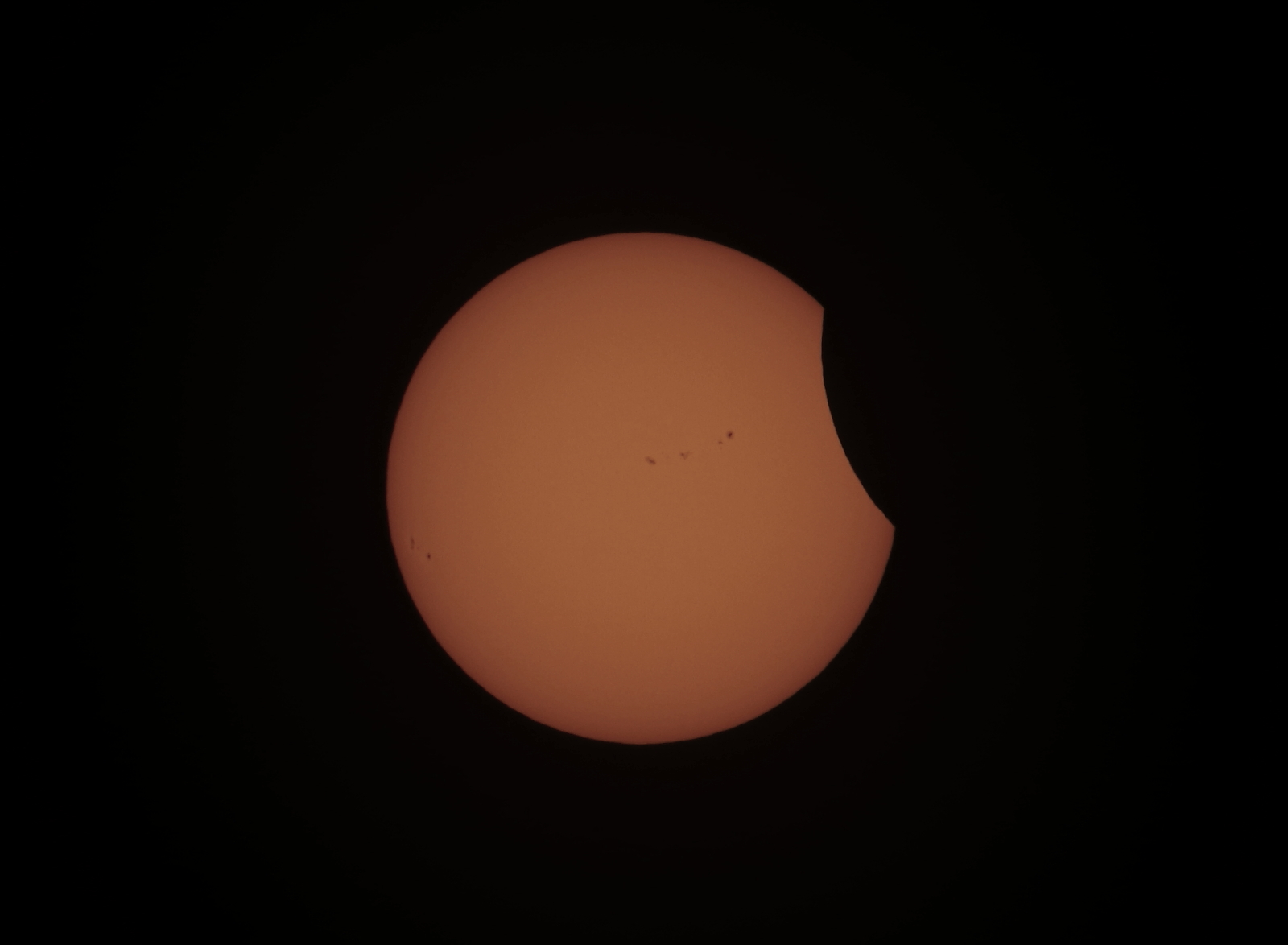December 20, 2017
Merope and IC 349 (Sept. 2017)
This is an oft-imaged nebula. I have imaged it before (search in the window at top left for earlier images). Merope is the bright star, and IC 349 is the tiny, fan-shaped nebula reflecting Merope's light, just to the right of the star under the diffraction spike. The nebula may be responding to radiation pressure from Merope, being slowly swept away, but this is not known. Anyway, the nebula is a challenge to see, and I've taken several images of it. I think it looks like an angelfish, so to me it is the Angelfish Nebula.
This image was taken at 2353mm with the CFF Classical Cassegrain and the SXVF-H9.
December 17, 2017
Holoea! (November 2017)
This is the western half of the open cluster M36. Please find the curious object that looks like a comet with an upward sweeping tail. Look at about 6:30, halfway from center to lower left edge. This is Holoea. The three different versions of the image highlight different parts of this faint object. After you have found Holoea, please see the write-up below.
Holoea means "flowing gas." This object was discovered in 1995. No one is certain just what it is, yet. Spectroscopy and radio interferometer observations suggest that the object involves a K2 star, two young stellar objects (YSOs) that are moving toward star status, and one pre-stellar condensation of gas that is beginning to glow. Just how those objects are together in the sky is not clear yet, but something, probably one of the YSOs, is ejecting gas outward at 650 kilometers per second! The system is considered a valuable information source for the stage of star formation between (i) condensing gas cloud and (ii) the point at which a YSO no longer accretes gas.
This image is 17x720" with the SXVF-H9C and Astronomik CLS filter through the CFF 290 Classical Cassegrain at f/8.1. I thought I might make a color image, but the object is so faint that color would not have been pretty.
Reports are that Holoea has grown brighter, and perhaps it has since the 1950s, but my full-visual-spectrum image suggests it is around magnitude 18.5, something close to the measurement taken in the 1990s. The faintest stars in the image are around magnitude 20.
My report relies on 2 Jeff Kanipe & Dennis Webb, Annals of the Deep Sky 156 (Willmann-Bell 2015); O. Morata, Y.-J. Kuan, P.T.P. Ho, H.-C. Huang, E.A. Magnier, and R. Zhao-Geisler, Millimetric and Submillimetric Observations of IRAS 05327+3404 "Holoea" in M36, 146 The Astronomical Journal 1 (2013), at http://iopscience.iop.org/article/10.1088/0004-6256/146/3/49/pdf ; and Magnier's original paper (1996) for the magnitude measured in the 1990s. I learned of Holoea from Kanipe and Webb.
December 4, 2017
NGC 1514 (Fall 2017)
This lovely planetary nebula sits on the northern edge of the constellation Taurus, almost in Perseus. It is visible in late fall and winter. NGC 1514 was discovered by William Herschel in November 1790. His study of it is supposed to have persuaded him that not all fuzzy deep sky objects were unresolved groups of stars; this one, he thought, looked like something else.
Perhaps what persuaded him was the very bright star at its center, such a contrast to the nebulosity surrounding it. The star at the center is a spectroscopic double star. A study released in 2017 shows that the two stars have a highly eccentric orbit of about 9 years! (Thanks, Mike Ressler, for the tip (see the comments).) This study followed other studies that suggested an orbit as short as 10 days (2003) or that the two stars did not orbit each other at all (2016).
In 2010, a NASA infrared telescope revealed that NGC 1514 has two, symmetrical rings around it. The rings are located outside of the nebulosity shown above and glow in a part of the spectrum not picked up by my camera. It is proof that even well-studied objects can present new mysteries.
This image is 19x600" through an OIII filter with the SXVF-H9 and 36x720" through an Astronomik CLS filter with the SXVF-H9C. All sub-frames were taken through the CFF 290 Classical Cassegrain at eff. f/8.1 in Fall 2017.
November 25, 2017
M43 (Nov. 2017)
Here is M43, the nebulosity surround in NU Orionis, the brightest star in this image. NU Orionis is a B-type star and radiates UV radiation that probably makes M43 glow.
This image is just 16x240" through the CFF 290 Classical Cassegrain at eff. f/8.1 on a night of about average seeing, which means that 2453mm is too long for the seeing conditions. It was shrunk 14% to accommodate the poor seeing conditions. Still, it is an interesting image. M43 is always overlooked for its near neighbor M42.
November 2, 2017
M76 (Fall 2017)
I gathered data for this image over four nights in September and October. M76 is found in our constellation Perseus. Looking back, I should have taken much longer OIII subs. I started out with 8-minute subs for narrowband, but the extended lobes of the nebula remain mostly invisible without longer exposures. For the last Ha, I switched to 20-minute subs.
This is 31x480 in OIII, 9x480 in Ha, and 14x1200 in Ha. Camera was the SXVF-H9. Telescope was the CFF 290 Classical Cassegrain at eff. f/8.1.
October 21, 2017
NGC 7008 (September 2017)
For this image, I gathered 7x720" in H-α and 8x720" in OIII, using Astronomik narrowband filters, through the CFF 290 Classical Cassegrain with the SXVF-H9 camera.
October 4, 2017
Sirius A and B (September 2017)
This famous double star is the brightest star in the sky. It is only 8.6 light years away. There is nothing particularly noteworthy about the brighter component. It a fairly small, type-A star. It appears bright only because it is close.
The companion, however, Sirius B, was one of the first white dwarf stars discovered. Sirius B is nearing the end of its life cycle. It used to be a large, blue star, but it burned up its nuclear fuel. With fusion no longer radiating energy outward, gravity shrunk the star's core. Sirius B retains as much mass as our Sun but is now roughly the size of Earth. With no fusion taking place, it will gradually cool (over hundreds of millions of years). What an amazing object!
Sirius A and B are difficult to see separately when they are closest together, but now they are quite far apart, over 10 arcseconds. Even now, though, the brighter star might overwhelm the dimmer one when viewed through a telescope. I caught them on a steady night and took 500 0.02-second frames, weeded out the blurriest 193 of these, then stacked the remaining 307. The four diffraction spikes around the bright star are a result of light interacting with the pieces of metal holding up a mirror in the light path of my telescope. Telescope: CFF 290 Classical Cassegrain (@ effectively f/8.1). Camera: SXVF-H9. Filter: Astronomik 6nm H-alpha.
October 3, 2017
NGC 7331 (September 2017)
NGC 7331, the big galaxy in this image, appears in our constellation Pegasus. The galaxy is roughly 47,000,000 light years away. We see its spiral shape at a dramatic angle.
Equally
intriguing are the smaller background galaxies. Across the upper part
of the image, NGC 7337, NGC 7335, and NGC 7336 float over 7331 like
seagulls about to dive. NGC 7337 and 7335 lie far in the background,
probably ~300,000,000 light years away from us, over 6x further than 7331. NGC
7336 is another hundred million light years further still.
Besides
these, the image shows numerous other bits of fluff—galaxies all, many
of which may be even further away. Including the large systems, I count at least fifteen galaxies in
the image. Some of these are far in the background.
In addition to the galaxies, the image shows many stars in our own galaxy. Stars as dim as magnitude 20 appear in the frame.
This image was taken in four sessions in September 2017,
and is 66x720" (13.2 hours) with the SXVF-H9 through the CFF 290
Classical Cassegrain at f/8.11, an effective focal length of 2353mm.
The frames were shot through an Astronomik CLS filter from a red zone.
September 2, 2017
Corona: Total Solar Eclipse, August 21, 2017, from Rexburg, Idaho
The total solar eclipse! I drove from Houston, Texas, to Rexburg, Idaho, to see it. I took my 9-year-old son. Fortunately, we could visit family on the way and while there. I filmed the event from my brother and sister-in-law's backyard. We had something of a family gathering, and it was fun.
The sky was wonderfully clear and blue. The eclipse had all the classic traits. The moon slowly moved across the sun. The air cooled substantially. The sky darkened. Venus, Mercury, and Mars came out. Regulus appeared to the left of the sun and moon (as shown in the images above). The sky at horizon all around turned red. The corona appeared. Prominences were seen (two of them!) at the moon's edge; these were visible without optical aid (but were over-exposed in the images I took). The re-appearance of the sun made a diamond ring. The moon slowly moved across the sun's face. And then it was over. My son was impressed: "Wasn't that a wonderful eclipse, Dad?" I think he asked me this five times that afternoon.
The Corona! and Corona with Contrast! images are variations on a combination of 4 bracketed images. Software used included Canon's Digital Photo Pro 4, Photoshop CS3, and Photomatix Pro 6.0.2. The camera was a Canon T3i. The telescope was a William Optics Zenithstar 61 with matching flattener. The scope and camera were guided on a Takahashi NJP.
August 27, 2017
Eclipse Progression, the Partials, from Rexburg, Idaho, on August 21, 2017
Here is the progression from first snap (somewhat after first contact) to last contact, less totality. (Totality is saved for another post.) As the morning progressed (from 10 am to 1 pm), the sun rose higher in the sky and seeing improved, so the later images are clearer. In fact, some are quite good for my little scope.
If you are using a computer (don't think it works on a phone) and click on any of the pictures, the site takes you to a screen where you can flip through the images successively with arrow keys. You can re-live the experience.
Subscribe to:
Posts (Atom)


































































